
Adjunct Professor
| Email: | bhmhwlam@cityu.edu.hk |
|---|---|
| ORCID ID: | 0000-0003-1213-3874 |
| Scopus Author ID: | 7202630175 |
- Smart stimulti-responsive materials for chemo-/biosensing and biomedical applications
Prof. Michael Hon-Wah Lam received his Ph.D. from the University of Hong Kong in 1990 and did his post-doctoral with the Nobel laureate (the late) Sir Geoffrey Wilkinson in the Johnson Matthey Laboratory of the Imperial College of Science, Technology & Medicine, UK. Before joining the City University of Hong Kong in 1994, he has also worked as a forensic scientist in the Government Laboratory of Hong Kong and as a water scientist in the Environmental Protection Department of Hong Kong.
Prof. Lam's current research interest lies in two areas: (1) the development of novel molecular, nano- and micro-scale materials for in vitro and in vivo imaging, and environmental analytical and biomedical applications; (2) in vitro and in vivo metabolomic studies of various environmental contaminations. His research group has applied the molecular imprinting technique to develop numerous chemosensors for environmental/food contaminants and "smart" stimuli-responsive polymer materials for controlled release and uptake of drugs. His group has also developed various highly luminescent organometallic platinum(II) complex systems and lanthanide-based nanomaterials for bio-labeling and cell imaging purposes.
Over 140 papers in international journals and 2 book chapter in areas of Analytical Chemistry, Environmental Chemistry, Organometallic & Coordination Chemistry and Cell Imaging. Some representative recent publications include:
- Elva Ngai-Yu Lei, Man-Shan Yau, Chi-Chung Yeung, Margaret B. Murphy, Ka-Leung Wong, Michael Hon-Wah Lam (2017). Profiling of Selected Functional Metabolites in the Central Nervous System of Marine Medaka (Oryzias melastigma) for Environmental Neurotoxicological Assessments, Arch. Environ. Contam. Toxicol., 72, 269–280.
- Ka-Lok Ho, Ka-Ki Yuen, Man-Shan Yau, Margaret B. Murphy, Yi Wan, Bonnie M.-W. Fong, Sidney Tam, John P. Giesy, Kelvin S.-Y. Leung, Michael H.-W. Lam (2017). Glucuronide and sulfate conjugates of tetrabromobisphenol A (TBBPA): Chemical synthesis and correlation between their urinary levels and plasma TBBPA content in voluntary human donors, Environ. International, 98, 46 – 53.
- Du Xuemin, Chiu Sharon Hiu-Man, Ong Daniel Hock-Chun, Vellaisamy Roy, Lam Michael Hon-Wah (2016). Metal ion-responsive photonic colloidal crystalline micro-beads with electrochemically tunable photonic diffraction colours, Sensors and Actuators B: Chem., 223, 318 – 323.
- Peng Hu, Tianshi Feng, Chi-Chung Yeung, Chi-Kin Koo, Kai-Chung Lau, Michael H. W. Lam (2016). A Photo-triggered Traceless Staudinger-Bertozzi Ligation Reaction, Chem. Eur. J., 22, 11537 – 11542.
- Yu-Man Ho, Ngan-Pan Bennett Au, Ka-Leung Wong, Chris Tsz-Leung Chan, Wai-Ming Kwok, Ga-Lai Law, Kwong-Kit Tang, Wai-Yeung Wong, Chi-Him Eddie Ma, Michael H. W. Lam (2014). A lysosome-specific two-photon phosphorescent binuclear cyclometalated platinum(II) probe for in vivo imaging of live neurons, Chem. Commun., 50, 4161 – 4163.
- Guanyong Su, Hongxia Yu, Michael H. W. Lam, John Giesy, Xiaowei Zhang (2014). Mechanisms of Toxicity of Hydroxylated Polybrominated Diphenyl Ethers (HO-PBDEs) Determined by Toxicogenomic Analysis with a Live Cell Array Coupled with Mutagenesis in Escherichia coli, Environ. Sci. Technol., 48, 5929 – 5937.
- Sheng Cheng, Bin Zheng, Mozhen Wang, M. H. W. Lam, Xuewu Ge (2014). A target-triggered strand displacement reaction cycle: The design and application in adenosine triphosphate sensing, Anal. Biochem., 446, 69 – 75.
- Sheng Cheng, Bin Zheng, Mozhen Wang, Xuewu Ge, Qing Zhao, Wei Liu, M. H. W. Lam (2014). The unfolding of G-quadruplexes and its adverse effect on DNA-gold nanoparticles-based sensing system, Biosens. Bioelectron., 53, 479 – 485.
- Xuemin Du, Ngai-Yu Lei, Peng Hu, Zhang Lei, Daniel Hock-Chun Ong, Xuewu Ge, Zhicheng Zhang, Michael Hon-Wah Lam (2013). In vivo imaging of the morphology and changes in pH along the gastrointestinal tract of Japanese medaka by photonic band-gap hydrogel microspheres. Anal. Chimica Acta, 787, 193 – 202.
- Xuemin Du, Ngai-Yu Lei, Hiu-Man Chiu, Xuewu Ge, Zhicheng Zhang, Michael Hon-Wah Lam (2013). Non-invasive in vivo imaging of the ionic regimes along the gastrointestinal tract of a freshwater vertebrate model organism (Japanese medaka) using responsive photonic crystal beads. J. Mater. Chem. B, 1, 1535 – 1540.
- Bin Zheng, Sheng Cheng, Wei Liu, M. H. W. Lam, Haojun Liang (2013). Small organic molecules detection based on aptamer-modified gold nanoparticles-enhanced quartz crystal microbalance with dissipation biosensor, Anal. Biochem., 438, 144 – 149.
- Jiefu Jin, Zhenhua Xu, Yue Zhang, Yan-Juan Gu, M. H. W. Lam, Wing-Tak Wong (2013). Upconversion nanoparticles conjugated with Gd3+-DOTA and RGD for targeted dual-modality imaging of brain tumor xenografts, Adv. Healthcare Mater., 2, 1501 – 1512.
- Ka-Lok Ho, Margaret B. Murphy, Yi Wan, Bonnie M. –W. Fong, Sidney Tam, John P. Giesy, Kelvin S. –Y. Leung, Michael Hon-Wah Lam (2012). Synthesis and Characterization of Bromophenol Glucuronide and Sulfate Conjugates for Their Direct LC-MS/MS Quantification in Human Urine as Potential Exposure Markers for Polybrominated Diphenyl Ethers, Anal. Chem., 84, 9881 – 9888.
- Yu-Man Ho, Chi-Kin Koo, Ka-Leung Wong, Cheuk-Fai Chow, Michael Hon-Wah Lam, Wai-Yeung Wong (2012). The Synthesis and Spectroscopic Studies of Cyclometalated Pt(II) Complexes with Cyclometalating Ligands Containing Imidazolyl Functionality, Dalton Trans., 41, 1792 – 1800.
- F. Y. Liu, S. Wiseman, Y. Wan, J. A. Doering, M. Hecker, M. H. W. Lam, J. P. Giesy (2012). Multi-species comparison of the mechanism of biotransformation of MeO-BDEs to OH-BDEs in fish, Aquat. Toxicol., 114, 182 – 188.
- G. Y. Su, X. W. Zhang, H. L. Liu, J. P. Giesy, M. H. W. Lam, P. K. S. Lam, M. A. Siddiqui, J. Musarrat, A. Al-Khedhairy, H. X. Yu (2012). Toxicogenomic mechanisms of 6-HO-BDE-47, 6-MeO-BDE-47, and BDE-47 in E. coli, Environ. Sci. Technol., 46, 1185 – 1191.
Research Interests and Projects
Special water-soluble photoisomerizable functional monomers are developed for the imprinting of pharmaceuticals and bio-molecules into bio-compatible cross-linked polymer matrices. The resultant molecularly imprinted polymer materials are able to specifically release and uptake the imprinted molecular species under designated photo-excitations. In this example, a photo-regulated molecularly imprinted hydrogel material is capable of selectively release and uptake paracetamol in neat aqueous solutions upon photo-excitation at 353 and 440 nm respectively.
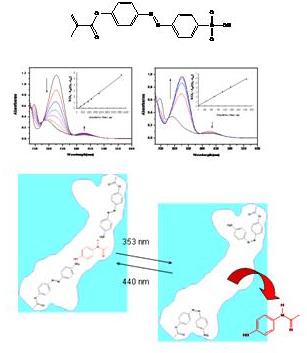
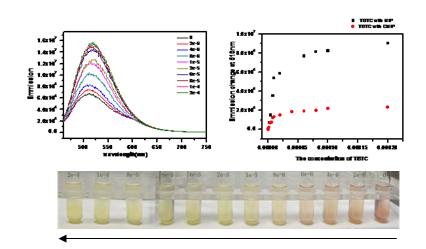
Special signal-transduction strategies are developed to report analyte binding events at the molecularly imprinted receptor sites to the outside world. In this example, a special molecularly imprinted polymer material is capable of producing colorimetric and fluorometric responses upon the binding of tributyltin chloride. This is the first time that tributyltin species can be detected by a chemosensor
Luminescent lanthanide-based nanoparticles and nanophosphors are fabricated and coated with a thin layer of organically modified silicate (ORMOSIL) for further functionalization. These nanomaterials can be useful tools for bio-labeling, cellular imaging and drug delivery applications. In this example, europium hydroxide nanorods are functionalized by a monolayer of methyl 2-phenoxybenzoates as an energy-transfer antenna. The resultant functionalized nanorods are able to be internalized by live cells (human lung carcinoma cells (A549)) with minimal cytotoxicity
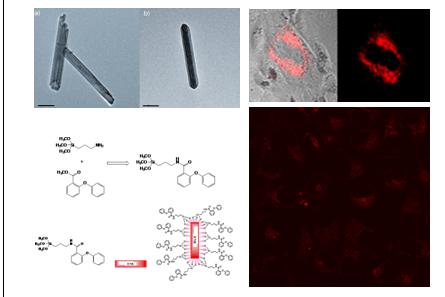
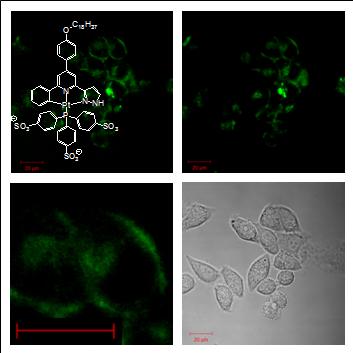
Special cyclometalated Pt(II) complexes with significant multiphoton absorption cross-sections and high quantum efficiency are designed and synthesized for bio-labeling and bio-imaging applications. Modification of these cycloplatinated luminophores with suitable functionalities can bring about desirable specificity in localization of these luminophores upon cell internalization. In this example, a novel water-soluble amphiphilic cyclometalated Pt(II) complex with a specially designed p-conjugated tridentate cyclometalating ligand containing a hydrophobic C-18 carbon chain and a highly water-soluble sulfonated triphenylphosphine ancillary ligand is an outstanding multiphoton dye for live cell plasma membranes. The complex is able to stay in the plasma membrane of live cells for over 3 hr with minimal cytotoxicity.
Special functional pendants are being explored to guide multiphoton luminescent probes to various important subcellular structures for live cell imaging and cell biological studies. In this example, a cationic triphenylphosphonium pendant is linked with a cycloplatinated two-photon luminophore. The resultant complex is a powerful multiphoton stain for cell nucleoli and an inhibitor of RNA transcription. Affinity of the Pt(II) complex for cell nucleoli is found to be due to its special interactions with some nucleoli-proteins.
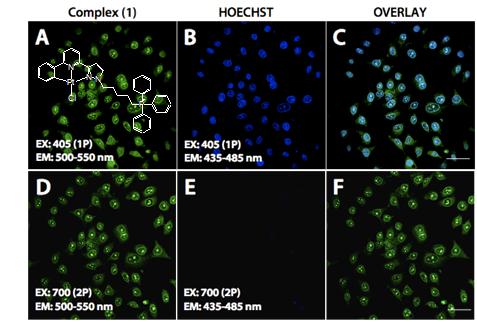
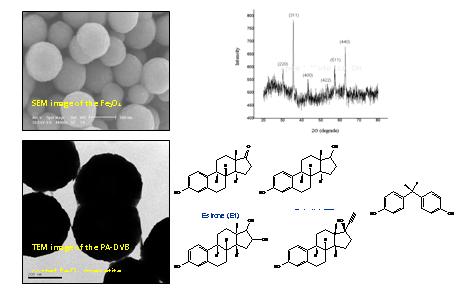
Special core-shell microspheres containing magnetite Fe3O4 cores with various types of polymer coatings of different physicochemical properties are fabricated for rapid magnetic-mediated micro-phase extraction (MPE) of selected trace organic contaminants in environmental waters and targeted bio-molecules and pharmaceuticals in biological fluids. In this example, a magnetite core-shell microspheric material with a poly(divinylbenzene-co-methacrylic acid) coating is able to pre-concentration very trace amount of selected estrogenic endocrine disrupting chemicals (EDCs) from sewages and human urine within 15 min.